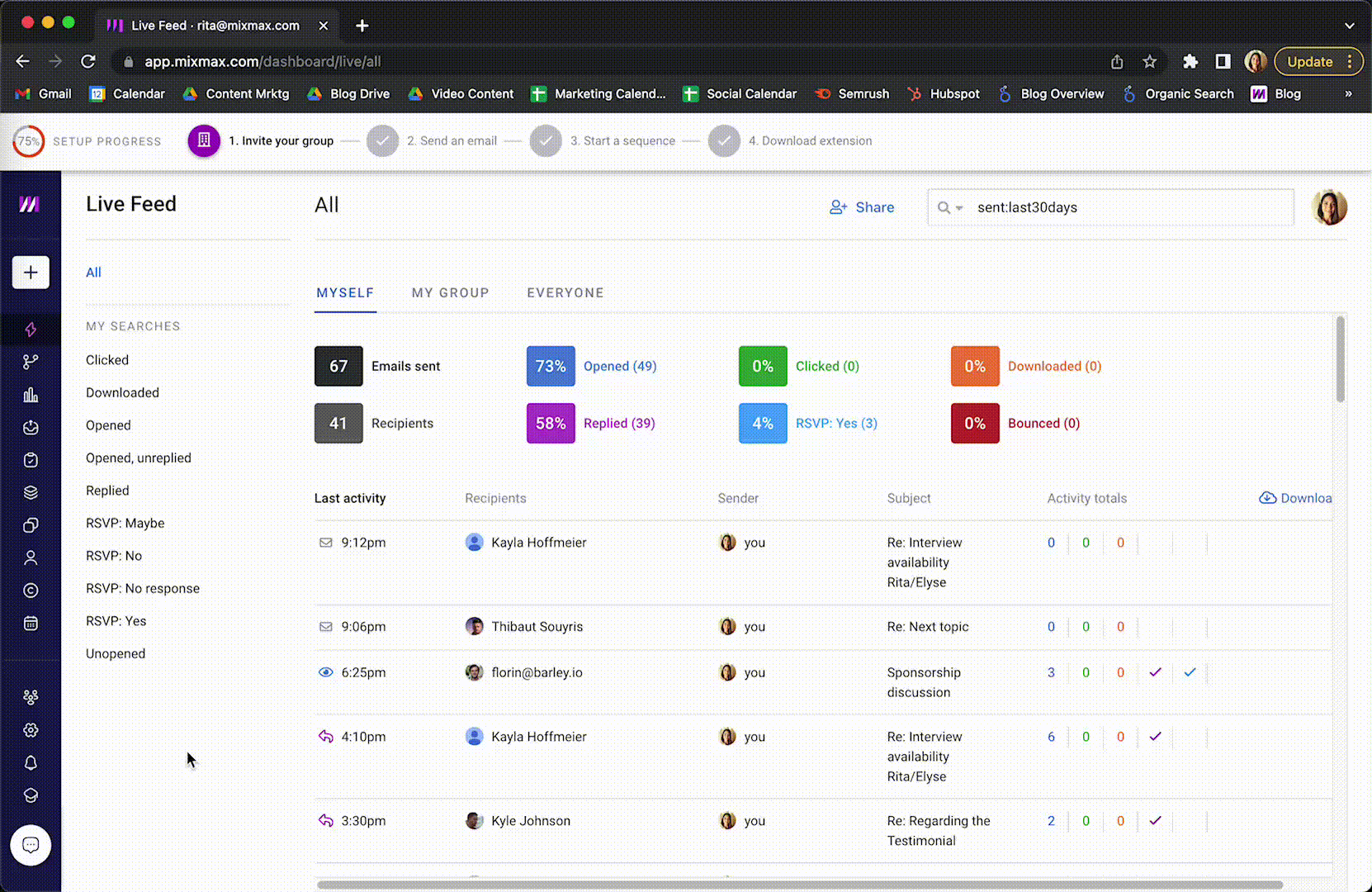
Following up with a prospect is one of the most important steps in the sales journey.
Get this:
Yep, you read that right.
Imagine what your team is missing out on by giving up after the first (or fourth) rejection.
Following up again (and again, and again, and again) is the name of the game when it comes to sales.
But there are ways of going about it that will increase your revenue team’s chances of engaging with prospects.
Getting your follow up email subject lines just right is one of them, especially since it’s what will encourage your recipients to either open or toss your email.
Here’s what we’ll cover in this post:
Here’s a list of the best follow-up email subject lines that can increase your email open rate and response rate. You can A/B test a few of these to see which ones resonate the most with your recipients.
|
💡 Fun fact: You can increase your open rate with AI Smart Send. It recommends the best time to send your follow up emails based on when your recipients are most active in their inbox.
|
According to a study by Marketo, a 7-word subject line (or roughly 41 characters) generates the highest overall engagement.
 Source: Marketo
Source: Marketo
Keeping your follow up email subject line short will force you to be creative and concise, which is what resonates the most with people.
Plus, since 42% of emails are opened on mobile, the shorter the subject line, the less likely it’ll be truncated.
The email preview text (AKA the email opening line) is almost as important as the subject line itself because it will appear in the recipient's inbox.
Don't waste that precious real estate.
Here’s what to keep in mind:
Using a natural and conversational tone conveys sincerity and easygoingness (is that a word?).
If your subject line is too formal or cold, it might turn people off.
Think of it like sending an email to a distant friend (NOT the bffs in your WhatsApp group). The tone you would use with that friend should be similar to the one you use in your follow up email subject line.
| Related post: Non-Obvious Cold Email Tactics to Increase Reply Rates |
When sending a follow-up email, do your best to personalize the subject line.
This doesn't mean using the recipient's name and calling it a day (which is an outdated tactic, so please don't).
To truly personalize it, try mentioning a relevant piece of content they’ve published, or a shared experience, or relevant news about their industry.
A little personal touch goes a long way.
P.S. Mixmax lets you personalize individual emails within a sequence, without editing the entire sequence itself ⬇️

Whatever you do, do not write a subject line that has nothing to do with the contents of your email. Your follow up subject line should communicate exactly what your email is about.
The last thing you want to do is to get your recipient to open the email and discover that they’ve been tricked or misled. Context is everything.
Being creative and evoking curiosity do NOT = clickbait.
You can build a sense of curiosity by offering a teaser in your subject line. A valuable piece of information, for example, but not one that gives away all the good stuff (cause then what would be the point of opening your email?)
No one wants to do business with someone who sounds desperate. When you’re following up with a prospect, it’s probably because they haven’t replied to your previous email(s), and/or you want to pick up momentum after the last interaction.
A follow up subject line like “Please reply” or “Sorry for bothering you again” or “If it’s not too much trouble” probably won’t work, though, so best to avoid those. (You’ll see what does work later).
| Related post: 7 Tips to Make Follow-Up Emails More Effective |
You know your email is a follow up.
They know your email is a follow up.
Writing “Quick follow up” in your subject line is unnecessary (and kind of annoying).
While crafting follow-up email subject lines can feel straightforward, there are common mistakes that many revenue teams fall into. These pitfalls can easily undermine even the best follow-up efforts, so here’s how to sidestep them and keep your outreach effective.
Pitfall: Follow-up subject lines that come off as aggressive, like “Why haven’t you responded?” or “Still waiting on your reply,” can put off prospects. No one likes to feel pressured or guilt-tripped into replying.
How to avoid: Strike a balance between persistence and professionalism. Use subject lines that offer value or curiosity without making the prospect feel uncomfortable. A line like “Ready to move forward? Let me know your thoughts” works better than a demand for a response.
Pitfall: Sending follow-up emails at the wrong time can lead to missed opportunities. If your prospect's inbox is full of unread emails when your follow-up lands, your subject line might be overlooked, no matter how good it is.
How to avoid: Use tools like Mixmax’s AI Smart Send to time your follow-up emails when your recipient is most likely to be active. This small tweak can significantly boost your open rates by reaching them at just the right moment.

Pitfall: Generic follow-up subject lines like “Just following up” or “Checking in” fail to catch attention because they don’t speak directly to the recipient. In a crowded inbox, these can get lost.
How to avoid: Personalize your subject lines with context from your previous interactions. Mention a specific point from your last meeting or something relevant to their industry. “Your thoughts on [topic]?” or “Ready to explore [project]?” show that the email is tailored to them.
Pitfall: Sending follow-up emails with subject lines that don’t provide any clear value can come across as noise. If your prospect feels like opening your email won’t benefit them, they won’t engage.
How to avoid: Use your subject line to give a preview of the value inside the email. Whether it’s answering a question or providing a resource, make sure the recipient knows what they’ll gain from reading your message. For example, “Here’s the info I promised” or “Quick tip for [problem].”
Pitfall: Subject lines that have been used too often, like “Just checking in,” may get overlooked because they lack creativity and originality.
How to avoid: Keep it fresh by experimenting with different angles or playing with humor and curiosity. Instead of “Just checking in,” try something like “Did I miss your reply?” or “Here’s a thought—let’s reconnect.”
Sales automation makes it possible for you to send personalized follow-up emails based on actions taken by prospects.
Sales engagement platforms like Mixmax have automation built-in, making it easy for revenue teams to eliminate manual tasks so they can focus on winning deals.
Here are some nifty sales automation features that will make following up a breeze:
Automatic follow-up prompts: Be automatically reminded to follow up with prospects or clients when they’ve interacted with your email a set number of times.
Rules based on triggers & actions: Set up rules to trigger automatic follow-up emails based on certain actions that your recipient has taken (or not taken). Check out this video on setting up Mixmax rules to learn more.
One-click meetings: If you intend to book a meeting with your recipient in your follow-up email, the easiest way to secure that call is to auto-populate your availability directly into the message. That way, they can just click on a time that works for them and boom–all done.

Learn more about one-click meetings here.
AI email scheduler (as mentioned above): What if you could auto-schedule an email sequence for when your recipients are most likely to be in their inbox? (Does such sorcery exist?) Yes, yes it does. You can find out the best times to send a follow-up email based on data collected by your sales engagement platform.

Rita Melkonian is the content marketing manager @ Mixmax with 8+ years of experience in the world of SaaS and automation technology. In her free time, she obsesses over interior design and eats her way through different continents with her husband & daughter (whose fave word is "no").
Once upon a time in a galaxy far, far away, Yesware was the go-to solution for AEs doing email outreach.
Times change.
And, while it’s made a valiant effort, Yesware just hasn’t been agile enough to maintain its position.

Sure, Yesware bills itself as a sales engagement solution but, truth is, the features leave a little something to be desired.
Ok, a lot.
Truth is, these days, it’s just not part of the sales engagement conversation anymore.

